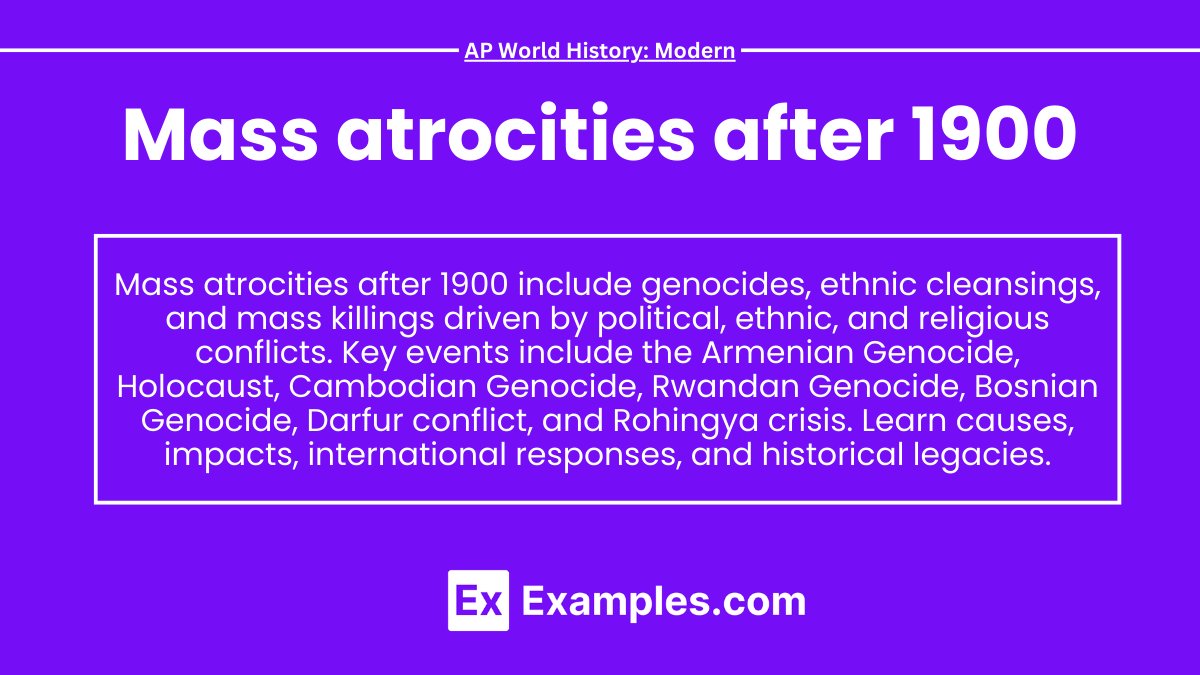Mass atrocities after 1900 significantly shaped global history, reflecting the consequences of political ideologies, ethnic tensions, and systemic violence. Events such as the Armenian Genocide, the Holocaust, and the Rwandan Genocide highlight humanity’s capacity for brutality. Understanding these atrocities is essential for recognizing the importance of human rights, international law, and the need for prevention in contemporary society.
Learning Objective
In studying “Mass Atrocities after 1900” for AP World History: Modern, you should learn to identify significant instances of mass violence and genocide, analyze their causes and consequences, and evaluate the global responses to these atrocities, understanding their lasting impact on international relations and human rights.
1. The Armenian Genocide (1915-1923)
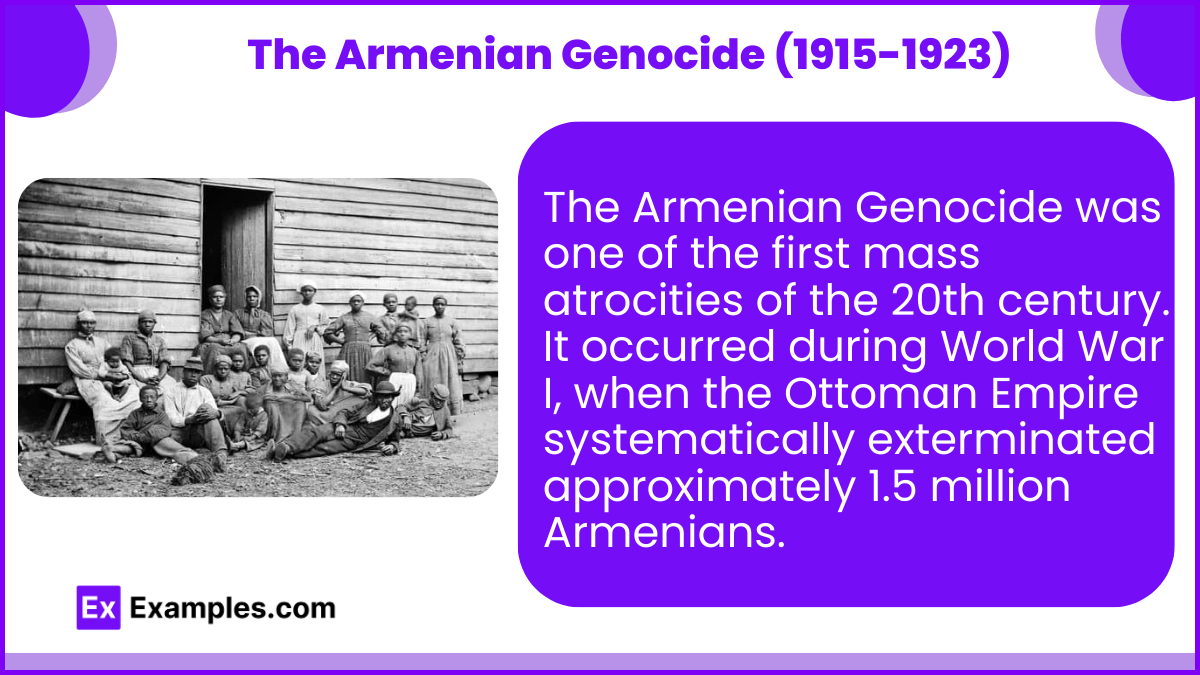
- Overview: The Armenian Genocide was one of the first mass atrocities of the 20th century. It occurred during World War I, when the Ottoman Empire systematically exterminated approximately 1.5 million Armenians.
- Causes: Rising Turkish nationalism, the Ottoman Empire’s fear of Armenian collaboration with the Allies, and long-standing ethnic tensions contributed to this genocide.
- Methods: Armenians were subjected to mass killings, forced death marches into the Syrian desert, starvation, and deportation.
- Impact: The genocide drastically reduced the Armenian population in the region and remains a controversial topic, as Turkey continues to deny its occurrence, while many countries recognize it officially.
2. The Holocaust (1939-1945)
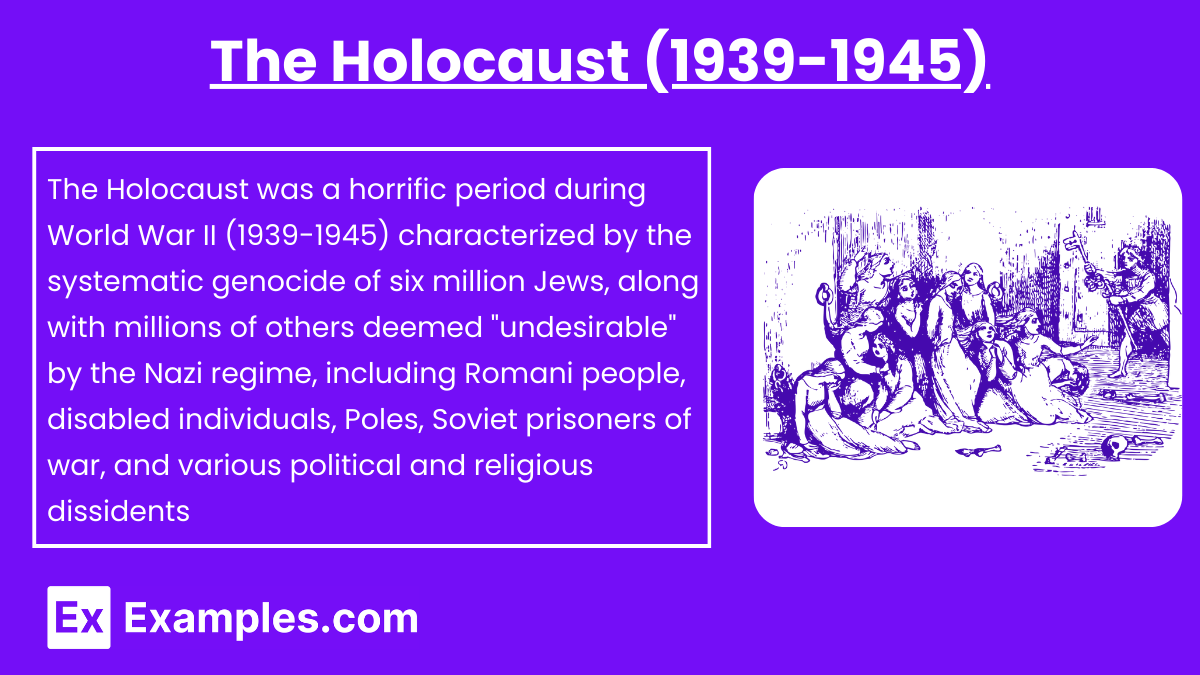
- Overview: The Holocaust was a systematic, state-sponsored genocide orchestrated by Nazi Germany that resulted in the deaths of approximately six million Jews, along with millions of others deemed “undesirable,” including Romani people, disabled individuals, Polish civilians, Soviet prisoners of war, and others.
- Causes: Adolf Hitler’s Nazi ideology, which promoted anti-Semitism and Aryan supremacy, was central to the Holocaust, along with Germany’s quest for territorial expansion and purification of the population.
- Methods: The Nazi regime employed concentration camps, gas chambers, forced labor, starvation, and mass shootings to exterminate Jews and other targeted groups.
- Impact: The Holocaust had a profound effect on global human rights, leading to the establishment of Israel, the Universal Declaration of Human Rights, and the Nuremberg Trials, which held Nazi leaders accountable.
3. The Rwandan Genocide (1994)
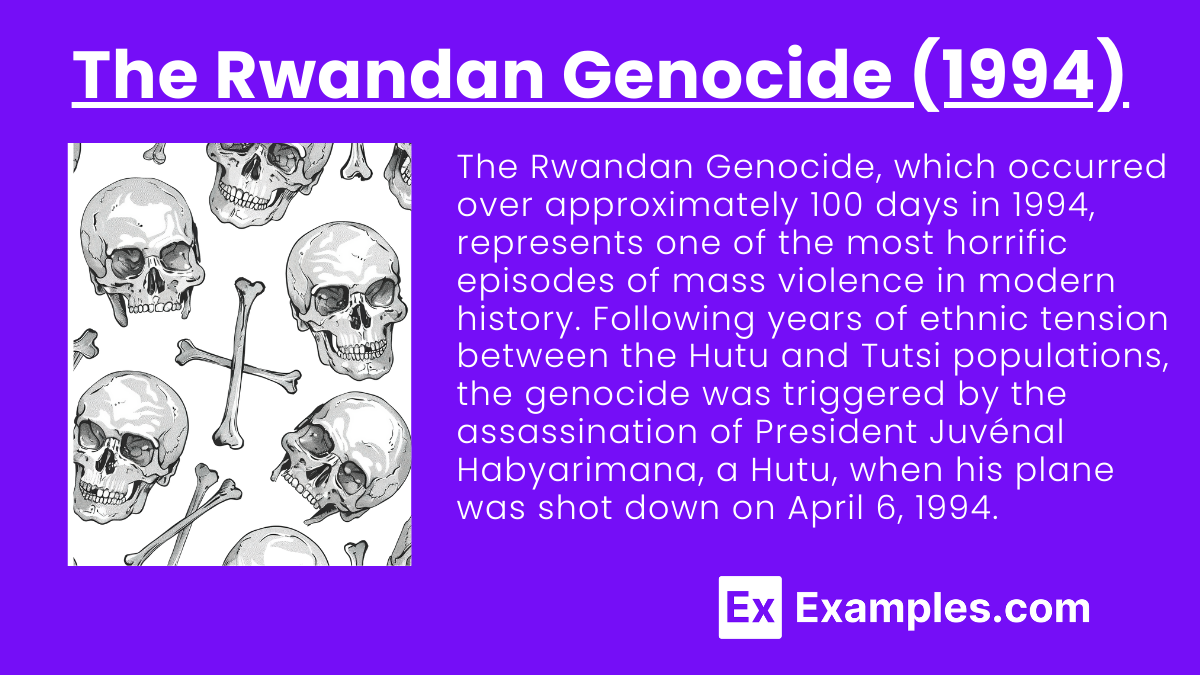
- Overview: The Rwandan Genocide, which occurred over approximately 100 days in 1994, represents one of the most horrific episodes of mass violence in modern history. Following years of ethnic tension between the Hutu and Tutsi populations, the genocide was triggered by the assassination of President Juvénal Habyarimana, a Hutu, when his plane was shot down on April 6, 1994. This event ignited long-standing grievances and escalated the violence.
- Causes: Long-standing ethnic tensions between the Hutu majority and Tutsi minority, political instability, and the assassination of President Juvénal Habyarimana triggered the genocide.
- Methods: Machetes, clubs, and firearms were widely used, and radio broadcasts incited violence, encouraging Hutu civilians to kill their Tutsi neighbors.
- Impact: The genocide devastated Rwanda, leaving deep scars on its population, with widespread trauma and orphans. It also highlighted the failure of the international community, particularly the UN, to intervene effectively.
4. The Cambodian Genocide (1975-1979)
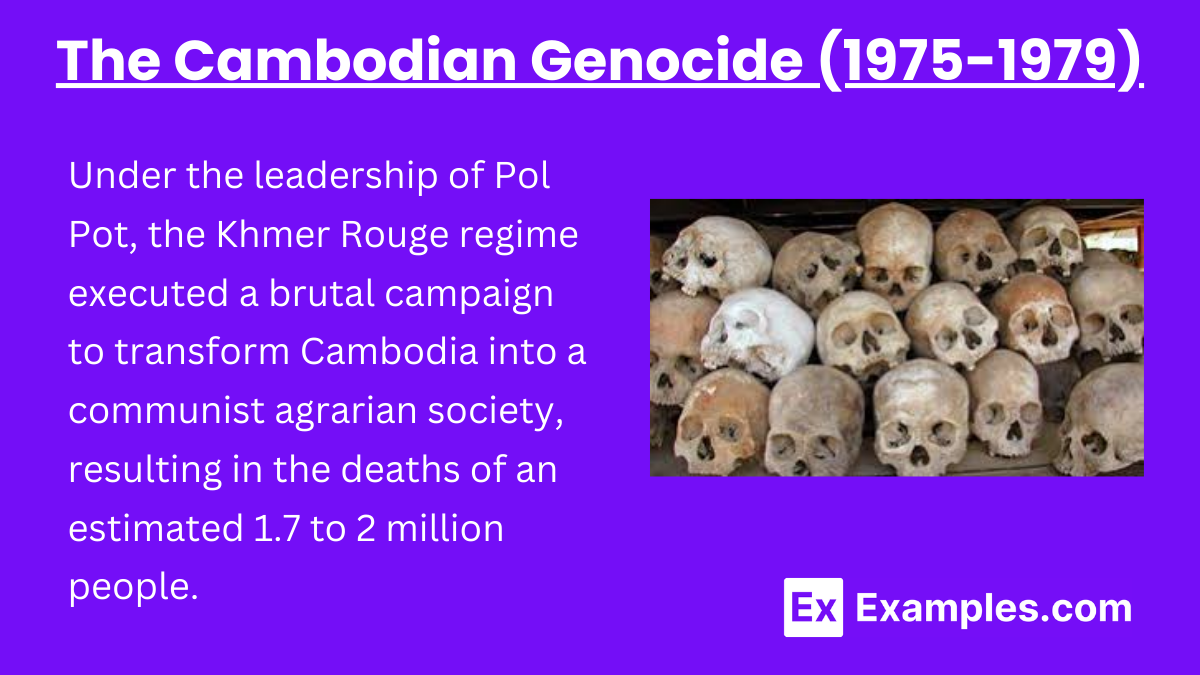
- Overview: Under the leadership of Pol Pot, the Khmer Rouge regime executed a brutal campaign to transform Cambodia into a communist agrarian society, resulting in the deaths of an estimated 1.7 to 2 million people.
- Causes: Ideological extremism, anti-intellectualism, and the desire to erase social hierarchies and capitalist influences led to widespread persecution.
- Methods: Mass executions, forced labor camps, starvation, and torture characterized the genocide, with targeted groups including intellectuals, professionals, ethnic minorities, and even children.
- Impact: The genocide decimated Cambodia’s population, destroyed its infrastructure, and left a legacy of trauma. It led to a delayed international response and later trials for some Khmer Rouge leaders.
5. The Bosnian Genocide (1992-1995)
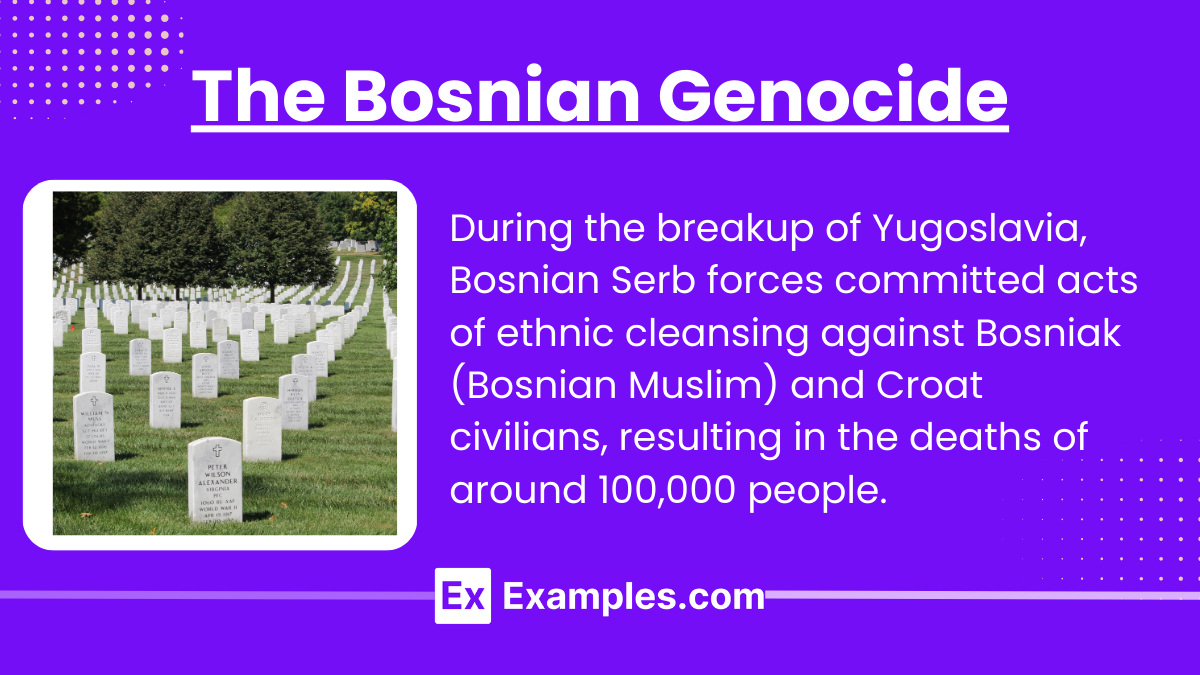
- Overview: During the breakup of Yugoslavia, Bosnian Serb forces committed acts of ethnic cleansing against Bosniak (Bosnian Muslim) and Croat civilians, resulting in the deaths of around 100,000 people.
- Causes: Ethnic nationalism, territorial disputes, and the desire to create a Greater Serbia fueled the violence.
- Methods: Mass killings, concentration camps, forced displacement, and systematic rape were employed, with the Srebrenica massacre of 1995 being one of the most infamous events.
- Impact: The genocide led to the intervention of NATO, the signing of the Dayton Accords, and the establishment of the International Criminal Tribunal for the Former Yugoslavia (ICTY) to prosecute war crimes.
Examples:
Example 1: Armenian Genocide (1915-1923)
The Ottoman Empire systematically exterminated 1.5 million Armenians, driven by ethnic nationalism and wartime paranoia, resulting in forced marches, mass killings, and lasting historical tensions.
Example 2: Holocaust (1939-1945)
Nazi Germany orchestrated the genocide of approximately six million Jews and millions of others deemed “undesirable,” employing systematic extermination methods including concentration camps and mass shootings.
Example 3: Rwandan Genocide (1994)
In just 100 days, Hutu extremists killed about 800,000 Tutsis and moderate Hutus, fueled by ethnic hatred and political instability, marking one of the fastest genocides in history.
Example 4: Cambodian Genocide (1975-1979)
The Khmer Rouge regime, led by Pol Pot, executed around 1.7 million people, targeting intellectuals and minorities to create a communist agrarian society, resulting in widespread suffering and trauma.
Example 5: Bosnian Genocide (1992-1995)
During the Bosnian War, Bosnian Serb forces committed ethnic cleansing against Bosniaks and Croats, leading to approximately 100,000 deaths and widespread displacement, exemplified by the Srebrenica massacre.
MCQs
Question 1
Which event is considered the first modern genocide of the 20th century?
A) The Holocaust
B) The Armenian Genocide
C) The Rwandan Genocide
D) The Cambodian Genocide
Answer: B) The Armenian Genocide
Explanation
The Armenian Genocide, which occurred between 1915 and 1923, is widely recognized as the first modern genocide of the 20th century. The Ottoman Empire’s systematic extermination of 1.5 million Armenians set a precedent for future atrocities, highlighting the dangers of state-sponsored violence against specific ethnic groups.
Question 2
What was a significant consequence of the Holocaust?
A) Establishment of the United Nations
B) Creation of the International Criminal Court
C) Formation of the state of Israel
D) End of World War II
Answer: C) Formation of the state of Israel
Explanation
The Holocaust’s horrific toll on the Jewish population and the need for a safe homeland for Jews directly contributed to the establishment of Israel in 1948. This geopolitical change was influenced by the widespread recognition of the dangers of anti-Semitism and the urgent need for Jewish self-determination following World War II.
Question 3
Which of the following best describes the primary method used during the Rwandan Genocide?
A) Gas chambers
B) Systematic starvation
C) Mass shootings and machete attacks
D) Concentration camps
Answer: C) Mass shootings and machete attacks
Explanation
During the Rwandan Genocide in 1994, Hutu extremists predominantly used mass shootings and machete attacks to carry out the extermination of Tutsis and moderate Hutus. The brutality and speed of these attacks highlighted the deep-rooted ethnic tensions in Rwanda and the failure of international intervention to prevent the violence.

